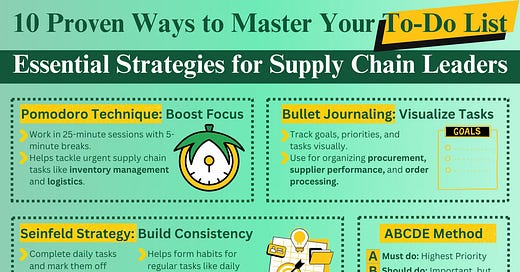The AI Revolution in Supply Chain Management: From Manual Chaos to Digital Mastery
⚙️ How Supply Chain Leaders Can Overcome Trust Barriers and Harness AI for a Competitive Edge
🚚 The AI Revolution in Supply Chain Management: From Manual Chaos to Digital Mastery
In today’s fast-paced world, industries are evolving at lightning speed. Yet, one sector remains stuck in the past—supply chain management. Despite the global rise of AI and automation, supply chain managers, planners, and directors—especially in Europe and beyond—continue to rely on manual processes.
But why is this? 🤔 It’s not because they don’t understand the potential of AI; rather, it’s due to years of false promises, failed digital transformations, and a lack of trust in the technology. Supply chain leaders have seen change attempts fall short, making it incredibly difficult for them to digitally adapt.
This article will break down how AI and digital tools can completely transform supply chains and why it’s crucial for managers to embrace this shift now. 🌍
🚧 The Roadblocks: Trust, Technology, and Transformation
The main issue is trust. Supply chain leaders are hesitant because they’ve experienced technology initiatives that didn’t deliver on their promises. The silent crisis in supply chains discusses how manual processes still dominate, despite the growing need for AI-driven solutions.
For leaders, adopting AI isn’t just about improving efficiency—it’s about rebuilding trust in technology. It’s essential for managers to realize that AI isn’t just a buzzword, but a tool that can eliminate manual inefficiencies and boost decision-making.
🧠 7 Proven Strategies for Overcoming Manual Work and Adopting AI
Here are seven proven strategies that supply chain leaders can use to navigate the AI shift and embrace digital transformation:
1. Unlock Mental Models for the AI Shift
The AI mental models used by top leaders are critical for overcoming the shift. These models help managers think differently and embrace AI-driven solutions. Leaders must adopt new mental frameworks to prepare for this change.
2. Ditch Manual Work for AI-Powered Systems
It’s time to ditch the manual and embrace automation. The post on ditching manual work shows how AI can handle repetitive tasks like inventory management and forecasting, freeing up human resources for higher-value tasks.
3. Transform Chaos into AI-Driven Excellence
In The Future of Supply Chain: From Manual Chaos to AI-Driven Excellence, we explore how AI can organize chaos. By integrating AI into decision-making, supply chains can shift from reactive operations to proactive solutions.
4. Mastering Data Leadership
Data is the backbone of AI success. Leaders need to understand data strategy. The post on mastering data leadership explains how strong data leadership drives AI adoption and ensures data integrity to fuel AI applications.
5. The Digital Transformation Playbook
Digital transformation is a mindset. In the Digital Transformation Playbook, I outline the importance of developing a growth mindset to lead teams through the digital journey. Leaders must prioritize agility and continuous innovation.
6. Tech Leadership for Driving AI Adoption
In the 8 Tech Leadership Strategies, I discuss how tech-savvy leaders can champion AI initiatives. Supply chain managers need to embrace their role as AI champions and guide their teams toward technological change.
7. The Silent Crisis: Why Manual Work Still Prevails
The silent crisis highlights why many supply chain leaders still rely on manual processes. Overcoming this resistancerequires strong leadership, ongoing education, and a clear vision for digital transformation.
🌍 Case Studies: Real-World Examples of AI in Supply Chains
Let’s take a look at how other companies are leading the AI charge in their industries:
1. Spotify’s Data-Driven Culture
Discover how Spotify used AI to enhance scalability and personalization. Supply chain leaders can learn from their data-driven approach to demand forecasting and optimization.
Learn how ING adopted agile methodologies to increase innovation and speed. Supply chain leaders can use these agile practices to adapt quickly in a tech-driven world.
AI is transforming logistics, enabling smarter decisions in route optimization and real-time tracking. This case study demonstrates the powerful role of AI in streamlining supply chains.
4. Optimizing Data Management by a Global IT Giant
See how an IT leader improved data management, saving costs and boosting efficiency—an approach that can be mirrored in inventory and supplier data management.
5. Fashion Retailer’s Data-Driven Strategy
A fashion retailer transformed operations with data-driven strategies, resulting in 40% operational efficiency. Supply chain leaders can apply similar techniques for better inventory and sales management.
Merck’s digital transformation integrated AI to drive greater efficiency in supply chain operations. Learn how their data strategy empowered AI-powered decisions and innovation.
7. Citizens Bank’s Digital Transformation
Citizens Bank improved its data strategy and embraced digital tools to streamline operations. This case study provides insights for financial supply chains looking to digitize their processes.
🔑 Conclusion: Embrace the AI Revolution Now
The time for manual processes is over. Supply chain leaders must evolve or risk being left behind. AI isn’t just about improving efficiency—it’s about unlocking competitive advantage in a fast-moving world.
The key to success is adopting an AI-driven mindset, investing in data management, and leading through change. The AI revolution in supply chains is happening now, and those who embrace it will lead the way into the future.
Are you ready to embrace AI and digitally transform your supply chain?
📬 Subscribe for More Insights
Stay ahead of the curve with exclusive AI & supply chain insights delivered directly to your inbox. Subscribe today and get the latest strategies, case studies, and expert advice on navigating the future of supply chains.





